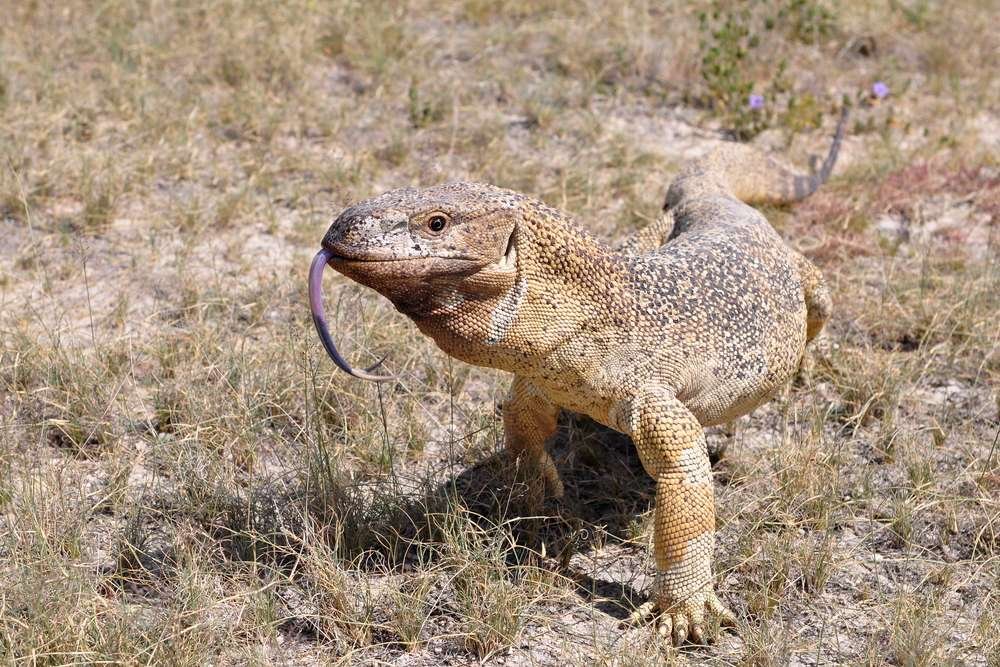White Throated Monitor
( Hopan or rock monitor )
- Varanus albigularis albigularis
- IUCN Status: Least Concern
- Threat: dangerous
- Venom/Toxin: none
- Trend: decreasing

- Phylum: Chordata
- Class: Reptilia
- Order: Squamata
- Family: Varanidae
- Genus: Varanus
Share:
General Information
The white throated monitor is one of three monitor lizards found in Zambia. It is bulkier and heavier than the Nile monitor. The white throated monitor is closely related to the mosasaur, a large, extinct sea monster that disappeared 65 million years ago.
Fun Facts!
The white throated monitor is large and heavy monitor lizard. They can run faster than humans over a short distance. They have a long tail that multitasks as a counterweight when running, an oar to help power it through the water and a whip with which to lash out at an assailant in self-defense.
Description
They are usually gray-brown with yellowish or white markings and light colored belly. They have muscular bodies, strong legs, powerful jaws and their nostrils are placed high on their snouts. Their teeth are sharp and pointed in juvenile animals and become blunt and peg-like in adults. They also possess sharp claws. Like all monitors, they have forked tongues, with highly developed olfactory properties.
- Length: up to 2 m
- Lifespan: 12-20 yrs
Ecology and Behaviour
It is hunted by birds of prey such as eagles. Males are extremely territorial. Upon encountering another male they will first take a threatening posture then begin fighting viciously, often leaving severe bite wounds. Monitors practice ‘open pursuit’ hunting instead of stalking and ambushing. They are very fast despite their massive size because of their powerful leg muscles. Monitors swallow their food whole or in large pieces; they are able to dislocate their thyroid bone in order to enlarge their throat.
Diet
The white throated monitor is an opportunist and lives on a broad variety of prey in the wild. Tortoises make up a significant part of their diet, and are swallowed whole due to the hard shell. Otherwise, they consume very little vertebrate prey, eating primarily invertebrates, especially millipedes, beetles, molluscs and orthopterans. Millipedes for example form nearly a quarter of their diet; the monitors are apparently resistant to its poisonous secretions. Although not averse to occasionally scavenging the corpses of vertebrate prey, even those as large as vervet monkeys, such prey seems usually too fast to catch for these monitors. This contrasts with what is often a diet of mostly vertebrates in captivity, such as rodents or poultry.
Reproduction
In March – May, a female white throated monitor breaks into a live termite mound to lay 20-50 eggs. The termites repair the damage, leaving the eggs to incubate in warm, humid conditions. They hatch with the following spring rains, when the softened soil allows the hatchlings to break out. When they hatch, baby lizards resemble tiny versions of their parents.
Conservation
It is categorized by the International Union for Conservation of Nature (IUCN) as, ” Least Concern “
Distribution and Habitat
They are found in Southern Africa, northwards to Angola, Zambia, and Mozambique. They prefer dry areas and they will usually use their long, sharp claws to dig their own holes.
Interaction with humans
This subspecies is usually kept as a pet. The eating of Water Lizard or Water Monitor (Hopan in Silozi is common among some Lozi people of Western province of Zambia. While the eating of water lizard is common in other ethnic groups as well such as the Sengas, Tumbukas and Ngonis, it is more pronounced among the lozi people, especially those found in the rural parts of the country. White throated monitors are often found in the pet trade despite their highly aggressive demeanor and resistance to taming.
No donation to this project yet.
| M | T | W | T | F | S | S |
|---|---|---|---|---|---|---|
| 1 | 2 | 3 | 4 | 5 | 6 | 7 |
| 8 | 9 | 10 | 11 | 12 | 13 | 14 |
| 15 | 16 | 17 | 18 | 19 | 20 | 21 |
| 22 | 23 | 24 | 25 | 26 | 27 | 28 |
| 29 | 30 | 31 | ||||


